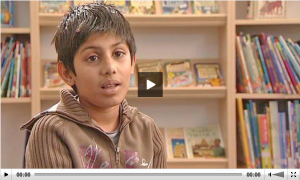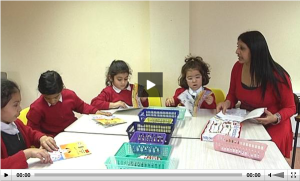Background
The National Curriculum Inclusion Statement (2000) states that schools need to set suitable learning challenges, respond to pupils’ diverse learning needs, and overcome potential barriers to learning. For children learning EAL, all three of these points are relevant, and so as teachers we need to consider carefully when planning to teach these pupils.
 Up to 70% of the world’s population speak more than one language on a regular basis,
Up to 70% of the world’s population speak more than one language on a regular basis,- In England around 200 languages are used alongside English in day-to-day life. (QCA, A language in common, 2005)
- Since 1997, the percentage of children whose primary language is other than English in primary schools in England has more than doubled, from 7.8% to 18.1%
- Currently one in six children in primary school in England does not speak English as their first language. (NALDIC, 2011)
Advantages to being bilingual
Recent research has shown that being bilingual can have a positive impact on cognitive ability, and can even help stave off dementia, (New York Times, 17/3/12). Training your brain to quickly switch between two languages has been shown to improve reaction times and problem solving ability, while learning a subject in one language also then makes it easier to transfer that knowledge into a new language, speeding subject knowledge acquisition. So if children with two or more languages are actually making more connections in their brains and developing deeper understandings, why then are they often viewed as being low achievers?
It is important to bear in mind that in of itself, not speaking English as a mother tongue is not a Special Educational Need, and does not imply deficiency in the child’s cognitive ability. However, it is not unreasonable to expect that such a child would require some extra support in an English-speaking classroom, in order to reach their full educational potential.
We must also consider the vast diversity and range of children all grouped under the umbrella term “EAL”, which can range from newly-arrived children, potentially from emotionally fraught backgrounds who speak no English at all at age 10, to children born in the UK to parents of a different first language, who speak that language at home, but have attended English-speaking schools since the age of 5. In fact, there is no one model for an EAL child in the primary classroom. Each child will have their own individual back story and unique knowledge that they bring with them, as indeed do native English-speaking children.
“Bilingual learners are not a homogenous group: when considering them not only must English language acquisition be taken into account but also a complex interplay of factors such as first language development, culture, ethnicity, previous schooling history and socio-economic status.” (DfES, 2007)
Assessing EAL
When assessing EAL children, it is important to remember that like monolingual children, EAL children may be at very different stages in different areas, such as speaking, listening, reading and writing. Based on the work of Jim Cummins, it is recognised widely (including in Ofsted inspections) that children become conversationally fluent more quickly, usually in two to three years. However, becoming academically and cognitively proficient in a new language takes much longer, often five to seven years, but sometimes even as long as ten years. (DfES, 2006)

The Silent Phase
It is also not uncommon for children to go through a “silent phase” when immersed in a new language, as they start to tune into the sounds of the new language and begin to make sense of the words they are hearing. Therefore, we must be mindful when assessing EAL children, that even if they are conversationally fluent in English, they may well still need further support to achieve their full potential academically. Conversely, a child may still be silent and unwilling to speak, but this does not mean that they are not understanding and taking in a wealth of information. For new learners of English, tactics such as time to think, orally rehearsing and working with an expert can scaffold learning.
The Dudley Language Descriptors can be a useful resource to help you assess what level your EAL student is on for speaking, listening, reading and writing.
Supporting EAL children
Based on the social-constructivist ideas of theorists such as Vygotsky, the pedagogy of EAL learners is not too different from that of monolingual children. EAL students benefit greatly from the contact with an “expert” or a fluent speaker of English, who can help scaffold their learning. This is why we must be mindful not to short-sightedly group EAL children with SEN children, as in fact speaking and listening to higher attaining children provides a better language model for their learning, as well as stimulating them more intellectually. Some top tips for EAL pedagogy:
- It is important that language is contextualised, for the maximum impact to be made.
- Where possible, providing EAL children with vocabulary ahead of time can be really helpful.
- As with a lot of children, visual cues and gesture can help make sense of what you are saying
Use of first language to support learning
Working with TA in home language
There is increasing recognition that continuing to speak and work in their home language can significantly increase children’s development, not only of English but also in general reasoning terms. Continuing to work in their home language improves both oracy and literacy skills, which can then be more easily transferred into English (EMAS, 09). This is particularly true for younger children moving into a new language environment (DfES, 2006). It is also important to remember that as EAL children are as cognitively able as monolingual children, they should be equally stretched. Sometimes it may be most appropriate to do this in their home language, to ensure even if their level of academic English is not high yet, they are still being challenged and having intellectual demands made of them. This learning will then be easier to transfer into English once it is secure in their home language. Plan to make use of
- Bilingual Teaching Assistants (where available)
- Support from community, council or national organisations, e.g. EMAS (The Ethnic Minority Achievement Service) for Brighton and Hove, which is a team of specialist teachers, teaching assistants and home liaison workers to support children with EAL in Brighton and Hove.
- Encouraging children and their families to work in their first language at home can help children to continue to develop, and will also make sure they feel their first language is still valued.
Resources
There is currently a wealth of material available to help teachers supporting children with EAL. A key site to visit for further information in a range of areas is NALDIC (The National Association for Language Development in the Curriculum.) Here you can read research and statistics, publications and reviews, find resources and download guides for teachers and schools on subjects such as planning, assessment, the curriculum and supporting EAL pupils.
Making children with EAL and their families and communities feel welcome and included is extremely important, and the following videos are a great introduction into the kinds of things schools and teachers can do to foster that feeling of inclusion:

This video is a brilliant example of a school that is celebrating its community’s diversity, and making all pupils feel welcome and included, regardless of their background or first language.

This video shows a great example of a primary school with a high proportion of children with EAL, and some of the approaches and strategies they use to support their pupils and their families.
Notwithstanding the fact that all learners of EAL are different and require different support, there are several standard “Top Tips” that can apply to most, if not all, pupils with EAL, such as
- Ensuring you make good eye contact and speak clearly
- Take the time to find out about the child’s home culture and language
- Learn a few key words to help the child settle in and feel welcome
- Making use of bilingual Teaching Assistants where they exist
- Pairing the EAL child with another, reliable pupil to act as translator.
Making your classroom a welcoming environment is an important step in making a child with EAL feel included. Also, developing good links with families and the community is definitely good practice, not only to help the child settle in, but also placing value on a child’s home culture and language has been shown to be beneficial, not only to their feeling of self-worth but also to their language development. Inviting a family or community member to come in and share a story, a religious festival or cultural traditions with the class is a fantastic resource to get all the children thinking, and to make your EAL child feel not only included, but also valued and unique.
The Ofsted website also provides free downloads of examples of best practice, including this school’s outstanding provision for children with EAL. This provides useful advice including the organisation of teaching groups, the use of Teaching Assistants, and assessment of EAL children.
The Department for Education Schools page provides resources, strategies and publications to help teachers working with children with EAL, available here.
The Ethnic Minority Achievement Service (EMAS) for Brighton and Hove provide lots of useful information and advice on their website, available here.
References
Armstrong, F., (2011), “Inclusive education: school cultures, teaching and learning” in Richards, G. and Armstrong, F. (Eds), Teaching and Learning in Diverse and Inclusive Classrooms: Key Issues for New Teachers, Routledge.
Bhattacharjee, Y., (17th March 2012), “Why Bilinguals Are Smarter”, New York Times Sunday Review, [online], Available via <http://www.nytimes.com/2012/03/18/opinion/sunday/the-benefits-of-bilingualism.html?_r=1&> [Accessed 18th November 2013]
Department for Education and Skills, (2005), Aiming High: Guidance on the assessment of pupils learning English as an additional language. Available via <http://www.naldic.org.uk/eal-teaching-and-learning/outline-guidance> [Accessed 26th November 2013]
Department for Education and Skills, (2007), Ensuring the Attainment of Pupils Learning English as an Additional Language. Available via <http://www.naldic.org.uk/eal-teaching-and-learning/outline-guidance> [Accessed 26th November 2013]
Department for Education and Skills, (2006), Excellence and Enjoyment: learning and teaching for bilingual children in the primary years. Available via <http://www.naldic.org.uk/eal-teaching-and-learning/outline-guidance> [Accessed 26th November 2013]
Sood, K., and Mistry, M.T., (2011), “English as an Additional Language: is there a need to embed cultural values and beliefs in institutional practice?” Education 3-13: International Journal of Primary, Elementary and Early Years Education, pp.203-215.
Qualifications and Curriculum Authority, (2000), A Language in Common: Assessing English as an Additional Language, Available via <http://media.education.gov.uk/assets/files/pdf/a/a%20language%20in%20common%20assessing%20eal.pdf> [Accessed 26th November 2013]
